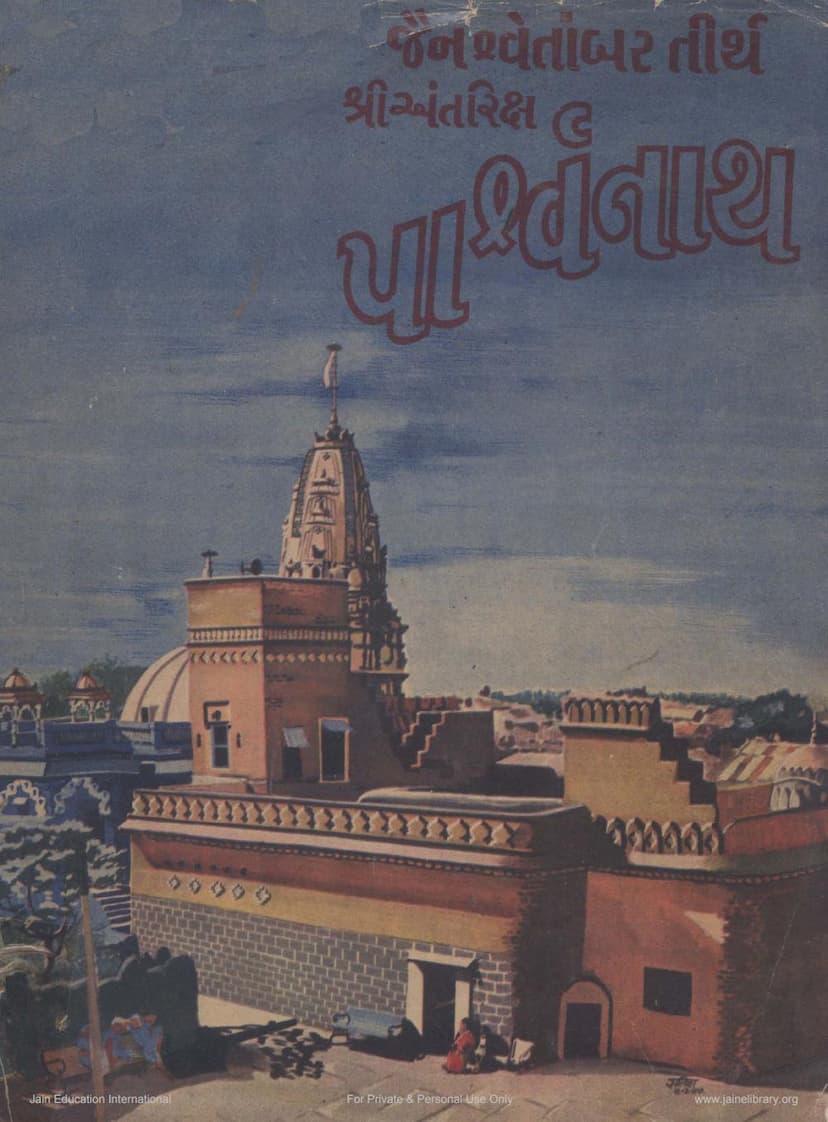Jain Shwetambar Tirth Antriksha Parshwanath
Added to library: September 2, 2025

Summary
Here's a comprehensive summary of the Jain text "Jain Shwetambar Tirth Antriksha Parshwanath," based on the provided pages:
Book Title: Jain Shwetambar Tirth Antriksha Parshwanath Publisher: Antriksha Parshwanath Sansthan, Shirpur Author: Pujya Gurudev Muniraj Shri Bhuvanvijayantvasi Muni Shri Jambuvijayji Maharaj
This book is a detailed account of the ancient and miraculous Jain Shwetambar Tirth of Shri Antriksha Parshwanath, located in Shirpur (District Akola, Maharashtra). It covers the origin, history, significance, and the long-standing legal battles surrounding the management and ownership of this sacred site.
Key Aspects Covered in the Book:
-
The Miraculous Idol:
- The central focus is the idol of Lord Parshwanath, which is described as being miraculously suspended in the air, not touching the ground or the back wall.
- Its height is approximately 36 inches from head to toe, and 42 inches including its hood. It is also 30 inches wide.
- The idol is described as being made of sand-mixed material, necessitating regular plastering (lep), which is a point of contention with the Digambari sect.
- The miraculous suspension is attributed to divine power and is a major draw for pilgrims, attracting millions over centuries.
-
Origin and History:
- The book traces the history of the Tirth from ancient times, citing various Jain scriptures and historical accounts.
- A significant narrative details the idol's origin as being created from sand by a servant of Ravana's minister.
- The idol was later discovered in a pond and brought to its current location by King Shripal of Vigal (or Vigelli) after his skin disease was cured by bathing in the pond's water. This event is linked to the idol's unique floating nature.
- The book discusses the differing accounts of the idol's installation, with some texts suggesting it predates Lord Parshwanath, while later accounts (like that of Muni Shri Bhavvijayji) place its installation after Lord Parshwanath's nirvana, attributing it to King Elach (Shripal) of Elachpur and Acharya Shri Abhaydevsuriji.
- The construction of the current temple is attributed to King Shripal according to some accounts, and to the followers of Acharya Shri Bhavvijayji.
-
The Shwetambari-Digambari Dispute:
- A major portion of the book is dedicated to the extensive and prolonged legal battles between the Shwetambari and Digambari communities over the management and ownership of the Tirth.
- The core of the dispute lies in the differing religious practices: Shwetambaris worship idols adorned with clothes, ornaments, and decorative marks, while Digambaris worship idols in a state of complete nudity.
- The Digambaris claimed the idol was originally in a nude state, while the Shwetambaris asserted it was originally adorned with a waist-tie (Katisutra/Kachota) and band. The plastering by Shwetambaris to maintain these features became a focal point of the conflict.
- The disputes escalated over many years, involving numerous court cases, including appeals to the Privy Council in England.
- Key Legal Milestones:
- A compromise in 1905 established a time-sharing arrangement for worship between the two sects.
- A major incident in 1908 involved Digambaris allegedly chiseling off the plaster, including the waist-tie and band, from the idol, leading to significant legal action.
- The Shwetambaris filed a lawsuit for exclusive management and recognition of their rights, which ultimately reached the Privy Council.
- The Privy Council, in its judgment of July 9, 1929, upheld the Shwetambari claim to exclusive management of the temple and idol. It also affirmed their right to worship with ornaments and maintain the idol's form through plastering, while granting the Digambaris the right to worship at specified times according to their customs, but without interfering with the Shwetambaris' management and plastering practices.
- Despite the Privy Council's ruling, disputes continued, with further court cases regarding possession of land, repairs, and the specific details of the plastering. The book documents numerous such legal proceedings and their outcomes.
-
Management and Administration:
- The book details the administrative structure, including the Tirth Committee, its office bearers, and members.
- It mentions the historical role of 'Polkars' as temple servants and the subsequent arrangement with them.
- The text highlights the dedication and efforts of various individuals and committees in managing and developing the Tirth, particularly after resolving the legal disputes.
-
Devotion and Faith:
- The book includes devotional hymns (stotras and stavans) in Gujarati and Sanskrit dedicated to Lord Antariksha Parshwanath.
- It emphasizes the faith and devotion of pilgrims from all walks of life, including Jain and non-Jain visitors, who are drawn by the idol's miraculous nature and the Tirth's sanctity.
- The text also includes testimonials and impressions from various dignitaries, officials, and visitors who have experienced the divine presence and appreciated the temple's management.
-
Supporting Documents:
- The book includes copies of court judgments, memorandums submitted to government officials, and correspondence related to the legal battles, providing substantial evidence for the Shwetambari claims.
- A detailed list of "Acts of Aggressions Done by the Digambaries" from 1908 to date is presented, citing specific case numbers and incidents to support the Shwetambari narrative.
-
Other Important Information:
- The book provides directions for reaching the Tirth from various major cities.
- It mentions other significant Jain Tirths associated with Lord Parshwanath, drawing parallels to their origins and miracles.
- The text discusses the importance of the Shwetambari Acharyas like Shri Vijaydevsuriji and Shri Bhavvijayji in the history and development of the Tirth.
Overall Message:
"Jain Shwetambar Tirth Antriksha Parshwanath" is a testament to the enduring faith, historical significance, and the miraculous nature of this revered Jain Tirth. It serves as a comprehensive record of its divine presence, its rich history, the arduous journey through legal challenges, and the unwavering devotion of its custodians, the Shwetambar Jains. The book aims to educate and inspire devotees by highlighting the glory and power of Lord Antariksha Parshwanath.